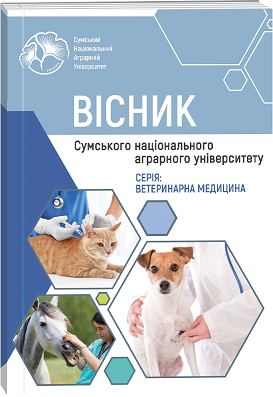BODY RESISTANCE OF CALVES AFTER BIRTH AND DURING THE IMPRINTING PERIOD DEPENDING ON THE FUNCTIONAL STATE
Abstract
The resistance of the organism of newborn calves and during the imprinting period depends on the conditions of growth and development of the fetus. The study of indicators of the hemocytopoiesis process and the resistance of the body of calves after birth and during the imprinting period was carried out in blood samples taken from the vessels of the umbilical cord and jugular vein. The negative influence of hypoxia on the processes of formation of the blood system and immunity in the body of the fetus, which in newborn animals are manifested by a violation of hemocytopoiesis, has been established. In animals that were born with signs of hypoxia, the formation of the phagocytic profile of the blood is significantly reduced, the activity of leukocytes is reduced, and, accordingly, the resistance of the body. After birth, the total number of leukocytes in the blood of functionally active calves was 1.72 times (p<0.01) less than that of calves born with signs of hypoxia. Taking into account the fact that calves are born with a larger number of neutrophils in the blood, and the blood profile in ruminants is lymphocytic during the period from birth to the end of the imprinting period (the first 6 days of life), the duration of the circulation of neutrophils in the blood is about 5-6 days in functionally active calves decreases. They are determined in blood 1.30 times more (p<0.05). At the end of the imprinting period, the content of neutrophils in the blood of calves of the second group increased to 65.20±4.42%, which is 1.59 times more than this indicator after birth. At the same time, the total number of lymphocytes in the blood at the end of the imprinting period decreases by 2.55 times (p<0.001), to 21%. The activity of the leukocyte unit of the body's defense is accompanied by a decrease in the body's resistance. The percentage of active leukocytes in the blood of calves of the control group was 2.81 times more than that of the calves of the second group. The activity of leukocytes made it possible to neutralize 24.42±1.96 x10 9 /l of microbial bodies in the blood of calves of the first group and only 11.19±1.03 x10 9 /l (2.18 times less) in animals of the second group. The research results show the negative impact of hypoxia on the processes of hemocytopoiesis and the resistance of the calf's body in the period after birth and in the imprinting period.
References
2. Campler, M., Munksgaard, L. & Jense, M.B. (2015). The effect of housing on calving behavior and calf vitality in Holstein and Jersey dairy cows . J. Dairy Sci., 98., r1709-1804
3. Chase, C. (2021). Practical immunology and beef and dairy v protocols: starting from ground zero–what, when and how, in Proceedings, Am Assoc Bov Pract Recent Graduate Conference; 10-18.
4. Ergander, U., Eriksson, M., Zetterström, R. (2008). Severe Neonatal Asphyxia. Acta Pædiatrica. Vol. 72. – № 3. – P. 321-325.
5. Forbes, K. (2010). Maternal growth factor regulation of human placental development and fetal . Journal Endocrinologe.-Vol. 207, № 1. – P.1-16.
6. Kambur, M. D., Zamazii, A. A., Kolechko, A. V., Lermontov, A. Y., Butov, O.V. (2018). Yakist krovi koriv pid chas tilnosti ta yii vplyv na vidtvorennia ta vyzhyvannia novonarodzhenykh teliat. [Blood quality of cows during calving and its effect on reproduction and survival of newborn calves]. Nauka ta osvita – novyi vymir, tom VI (157), Vyp. 17, S.26 – 29 https://doi.org/10.31174/send- nt2018-157vi17-06 ( in Ukrainian).
7. Kambur, M.D., Zamazii, A.A., Butov, O.V. (2018). Fiziolohichno– biokhimichni zminy v orhanizmi koriv uprodovzh tilnosti, rodovoho ta pisliarodovoho protsesu. [Physiologically – biochemical changes in the body of cows during pregnancy, birth and postpartum process]. Dnipropetrovskyi Naukovo-tekhnichnyi biuleten Naukovo – doslidnitkogo zentry biobezpeky ta ekolohichnoho kontroliu resursiv agropromucloworo komplekcy. 6, 2, 79-80 DOI: https://doi.org/10.32819/2018.63009 (in Ukrainian).
8. Krause, B. J., Hanson, M. A. & Casanello, P. (2011). Role of nitric oxide in placental vascular development and function. Placenta. Vol. 32, No 11. – P. 797-805.
9. Krehbiel, C.R. (2020). Bovine respiratory disease influences on nutrition and metabolism. Vet Clin Food Animal ; 36:361-373.
10. Langel, S.N, Wark, W.A, Garst, S.N, James, R.E, McGilliard, M.L. & Petersson-Wolfe, C.S (2015). Effect of feeding whole compared with cell-free colostrum on calf immune status: the neonatal period. J Dairy Sci. (2015) 98:3729 – 40. doi: 10.3168/jds.2014-8422
11. Lhermie, G., Toutain, P.L, El Garch F., Bousquet-Melou, A. & Assie S. (2017). Implementin Precision Antimicrobial Therapy for the Treatment of Bovine Respiratory Disease: Current Limitations and Perspectives. Front Vet Sci, 4:143. doi: 10.3389/fvets.2017.00143
12. Love, W.J., Lehenbauer, T.W, Karle, B.M., Hulbert, L.E., Anderson, R., AL Van Eenenaam, R. , Farver, T.B. & Aly, S.S. (2016). Survey of dairy practices associated with respiratory health of pre-weaned calves on California dairies. J. Dairy Sci. – http://dx.doi.org/10.3168/jds.2015-9394
13. Mazurkevych, A. Y., Karpovskyi, V. I., Kambur, M. D., Zamazii, A. A. (2008). Fiziolohiia tvaryn. Pidruchnyk.[Physiology of animals. Textbook.] Vinnytsia: Nova knyha, 424 ( in Ukrainian).
14. Meade, K.G. (2015). Advances in Bovine Immunology – New Tools and New Insights to Tackle Old Foes. Front, Immunoljgia -6:71. doi: 10.3389/fimmu.2015.00071
15. Murray, C.F. & Leslie, K.E. (2013). Newborn calf vitality: Risk factors, characteristics, assessment, resulting outcomes and strategies for improvement. Vet. J., 198, p. 322-328.
16. Murray, C.F., Veira, D.M., Nadalin Haines, D. M., Jackso, M.L. , Pearl, D.L. & Leslie, K.E. (2015). The effect of dystocia on physiological and behavioral characteristics related to vitality and passive transfer of immunoglobulins in newborn Holstein calves. Can. J. Vet. Res., 79 pp. 109-119
17. Murray, P.J. & Wynn, T.A. (2011). Protective and pathogenic functions of macrophage subsets. Nat. Rev. Immunologia., 11, pp. 723-737
18. Ott, T.L. (2019). Symposium Review: Immunological Detection of the Bovine Conceptus During Early Pregnancy. J Dairy Sci .-102 (4):3766 -77. doi: 10.3168/jds.2018-15668

 ISSN
ISSN  ISSN
ISSN 



